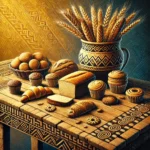1. Mandazi: The East African Doughnut
Origins and cultural significance
Mandazi, often referred to as the East African doughnut, holds a significant place in Kenyan culinary tradition. This pastry originated from the Swahili coast and has since become a staple across East Africa. Mandazi is deeply ingrained in Kenyan culture, often served during social gatherings, festivals, and as a popular breakfast item.
Traditional ingredients and preparation
The traditional recipe for mandazi includes flour, yeast, sugar, milk, and eggs. Some variations incorporate coconut milk or grated coconut for added flavor. The dough is typically shaped into triangles or squares and deep-fried until golden brown. The cooking process results in a slightly crisp exterior and a soft, fluffy interior.
Modern variations and serving suggestions
Contemporary versions of mandazi may include additional ingredients such as cardamom, cinnamon, or nutmeg for enhanced flavor profiles. Some innovative chefs have experimented with savory versions, incorporating herbs and spices. Mandazi is commonly served with tea or coffee and can be enjoyed plain or with accompaniments such as honey, jam, or chocolate spread.
2. Mahamri: Swahili-Inspired Coconut Triangles
Coastal influences on Kenyan cuisine
Mahamri, a close relative of mandazi, exemplifies the strong coastal influences on Kenyan cuisine. This pastry originated from the Swahili-speaking regions along the Indian Ocean coast, where coconut is a prevalent ingredient. The integration of coconut in mahamri reflects the tropical climate and agricultural practices of coastal Kenya.
Unique spice blend and coconut incorporation
What sets mahamri apart is its distinctive spice blend and the prominent use of coconut. The dough typically contains coconut milk or grated coconut, cardamom, and sometimes cinnamon. This combination creates a rich, aromatic pastry with a subtle sweetness and complex flavor profile.
Ideal pairings and consumption occasions
Mahamri is often enjoyed as a breakfast item or afternoon snack. It pairs exceptionally well with Kenyan chai (tea) or kahawa (coffee). During Ramadan, mahamri is a popular choice for breaking the fast. Its versatility allows it to be served alongside savory dishes such as beans or meat stews, creating a delightful contrast of flavors.
3. Mkate wa Sinia: Swahili Rice Bread
Historical background and regional popularity
Mkate wa Sinia, which translates to “bread of the platter,” is a unique Swahili rice bread that has been a part of coastal Kenyan cuisine for generations. This pastry gained popularity due to its relatively simple ingredients and the prevalence of rice in the region. It is particularly common in Mombasa and other coastal towns.
Step-by-step preparation process
The preparation of Mkate wa Sinia involves several steps:
- Rice is soaked overnight and then ground into a fine paste.
- The rice paste is mixed with coconut milk, sugar, and yeast to form a batter.
- The batter is left to ferment for several hours.
- Once fermented, the batter is poured into a greased circular tray (sinia).
- The tray is then placed in a larger pot with water at the bottom, creating a steam bath.
- The bread is steamed until it sets and develops a spongy texture.
Texture and flavor profile
Mkate wa Sinia has a unique texture that is somewhat similar to idli, an Indian steamed rice cake. It is soft, spongy, and slightly chewy. The flavor is mildly sweet with a subtle coconut undertone. The fermentation process imparts a slightly tangy note, adding depth to the overall taste.
4. Kaimati: Sweet Dough Balls
Similarities to Middle Eastern desserts
Kaimati bears a striking resemblance to various Middle Eastern desserts, particularly luqaimat or lokma. This similarity is likely due to the historical trade connections between East Africa and the Middle East. Kaimati consists of small, round dough balls that are deep-fried and then soaked in syrup.
Syrup variations and flavoring options
The syrup used for kaimati can vary, offering different flavor profiles. Common options include:
- Simple sugar syrup infused with cardamom
- Honey-based syrup with a touch of lemon
- Date syrup for a more complex sweetness
Some variations incorporate rosewater or orange blossom water in the syrup, adding a floral note to the dessert.
Festive associations and cultural importance
Kaimati holds a special place in Kenyan celebrations, particularly during Islamic festivals such as Eid al-Fitr and Eid al-Adha. The act of preparing and sharing kaimati strengthens community bonds and is seen as a gesture of hospitality. In some regions, it is also associated with wedding celebrations.
5. Vitumbua: Rice Pancakes with a Twist
Zanzibar origins and Kenyan adaptation
Vitumbua originated in Zanzibar but has been embraced and adapted in Kenya, particularly in coastal regions. These small, round rice pancakes showcase the culinary exchange between different East African cultures. The Kenyan version often incorporates local ingredients and flavors.
Essential equipment for authentic preparation
To prepare authentic vitumbua, specific equipment is necessary:
- A special vitumbua pan with small, round indentations
- A coconut grater for fresh coconut
- A blender or food processor for creating a smooth batter
Serving styles and accompaniments
Vitumbua is typically served warm and can be enjoyed in various ways:
- Plain, as a light breakfast or snack
- Dusted with powdered sugar for added sweetness
- Accompanied by a fruit compote or jam
- Paired with spiced tea or coffee
Some modern interpretations include savory versions, served with chutneys or as an accompaniment to curries.
6. Kalimati: Crispy Sesame Sticks
Ingredients and nutritional benefits
Kalimati, a popular Kenyan snack, primarily consists of wheat flour, sesame seeds, and spices. The inclusion of sesame seeds provides several nutritional benefits:
- High in healthy fats and protein
- Rich in minerals such as calcium, iron, and zinc
- Contains antioxidants that may support heart health
Techniques for achieving the perfect crunch
To achieve the characteristic crunch of kalimati, several techniques are employed:
- The dough is rolled very thin before cutting into strips.
- A low and slow frying method is used to ensure even cooking and maximum crispiness.
- The sesame seeds are toasted before incorporation into the dough, enhancing their flavor and texture.
Popular dips and complementary beverages
Kalimati is often enjoyed on its own but can be paired with various dips:
- Tomato-based chutneys
- Mint and coriander dips
- Yogurt-based sauces
These crispy sticks pair well with Kenyan chai, fresh fruit juices, or traditional fermented milk drinks like mursik.
7. Kamba: Wheat Flour Twists
Simplicity in ingredients and preparation
Kamba, a humble yet beloved Kenyan pastry, exemplifies simplicity in both ingredients and preparation. The basic recipe typically includes:
- Wheat flour
- Water
- Salt
- Oil for frying
The dough is kneaded, shaped into thin twists, and deep-fried until golden and crispy.
Versatility as a snack or meal accompaniment
Kamba’s versatility contributes to its popularity across Kenya. It can be enjoyed as:
- A standalone snack
- An accompaniment to tea or coffee
- A side dish with soups or stews
- A crunchy addition to salads
Regional variations across Kenya
While the basic kamba recipe remains consistent, regional variations exist:
- In coastal areas, coconut oil may be used for frying, imparting a subtle tropical flavor.
- Some regions incorporate spices like cumin or black pepper into the dough.
- In urban areas, flavored versions with garlic or cheese have gained popularity.
8. Kashata: Coconut Peanut Brittle
Evolution from traditional to modern recipes
Kashata, traditionally a simple coconut brittle, has evolved over time. The original recipe consisted of grated coconut and sugar, cooked until caramelized. Modern versions often include:
- Ground peanuts or cashews
- Cardamom or cinnamon for added flavor
- Honey as a natural sweetener
Texture variations: chewy vs. crunchy
The texture of kashata can vary depending on preparation methods:
- Chewy kashata is achieved by cooking the mixture for a shorter time and allowing it to cool slightly before shaping.
- Crunchy kashata requires longer cooking time and is often spread thin to cool completely before breaking into pieces.
Packaging and shelf life considerations
Due to its high sugar content, kashata has a relatively long shelf life. However, proper packaging is essential to maintain quality:
- Airtight containers or sealed plastic bags prevent moisture absorption.
- Adding desiccant packets can help preserve crispness in humid environments.
- Refrigeration can extend shelf life but may affect texture upon thawing.
9. Tusker Bites: Beer-Infused Pastries
Fusion of traditional pastry and local beer
Tusker Bites represent a modern fusion of Kenyan culinary traditions and contemporary tastes. These innovative pastries incorporate Tusker, Kenya’s iconic beer brand, into a traditional dough recipe. This combination creates a unique flavor profile that appeals to both pastry enthusiasts and beer aficionados.
Savory flavor profile and unique ingredients
The savory nature of Tusker Bites sets them apart from many other Kenyan pastries. Key ingredients and flavors include:
- Tusker beer, providing a malty undertone
- Whole wheat flour for a nutty taste and hearty texture
- Herbs such as rosemary or thyme
- Cheese, often cheddar or a local variety, for added depth
Pairing suggestions with Kenyan beverages
Tusker Bites pair exceptionally well with a variety of Kenyan beverages:
- Tusker beer, naturally complementing the flavors in the pastry
- Kenyan coffee, offering a contrast between savory and bitter notes
- Fruit juices like passion fruit or mango, providing a sweet counterpoint
10. Ugali Cakes: Reinventing a Staple Food
Transforming ugali into a sweet treat
Ugali, a staple food in Kenya made from maize flour, has been reimagined as a sweet pastry. This innovative approach involves:
- Using finely ground maize flour as a base
- Incorporating sugar and flavoring agents
- Adapting traditional cake-making techniques to work with the dense ugali texture
Experimental flavors and mix-ins
Chefs and home cooks have experimented with various flavors and additions to enhance ugali cakes:
- Fruits like bananas or mangoes for natural sweetness
- Nuts such as peanuts or macadamia for texture
- Spices including cinnamon, nutmeg, or cardamom
- Chocolate chips or cocoa powder for indulgent versions
Reception among traditional and modern consumers
The reception of ugali cakes has been mixed:
- Some traditionalists view it as an unnecessary alteration of a cultural staple.
- Younger generations and food enthusiasts appreciate the creative use of familiar ingredients.
- Nutritionists note the potential for incorporating whole grains into desserts.
Summary: The Rich Tapestry of Kenyan Pastries
The diverse array of Kenyan pastries reflects the country’s rich cultural heritage, historical influences, and culinary innovation. From traditional favorites like mandazi and mahamri to modern creations such as Tusker Bites and ugali cakes, these pastries offer a glimpse into Kenya’s evolving food landscape. Each pastry tells a story of regional flavors, cultural exchanges, and the creative spirit of Kenyan cooks.
FAQs
Where can I find authentic Kenyan pastries outside of Kenya?
Authentic Kenyan pastries can often be found in East African restaurants, specialty African grocery stores, or international markets in major cities. Some online retailers also offer packaged Kenyan pastries for delivery.
Are there gluten-free options among Kenyan pastries?
While many traditional Kenyan pastries contain wheat flour, some alternatives exist. Vitumbua, made from rice flour, is naturally gluten-free. Additionally, some modern adaptations of traditional recipes use gluten-free flours like cassava or sorghum.
How have Kenyan pastries evolved with changing dietary preferences?
Kenyan pastries have adapted to changing dietary preferences by incorporating healthier ingredients, reducing sugar content, and offering vegan or gluten-free versions. Some bakers experiment with alternative flours and natural sweeteners to cater to health-conscious consumers.
What are some common ingredients found in most Kenyan pastries?
Common ingredients in Kenyan pastries include wheat flour, coconut (milk or grated), cardamom, sugar, and vegetable oil. Many pastries also incorporate local fruits, nuts, and spices that reflect regional tastes and agricultural products.
Can Kenyan pastries be adapted for vegan diets?
Yes, many Kenyan pastries can be adapted for vegan diets. Eggs can often be replaced with mashed bananas or commercial egg substitutes, while dairy milk can be substituted with plant-based alternatives like coconut milk, which is already common in many recipes.











